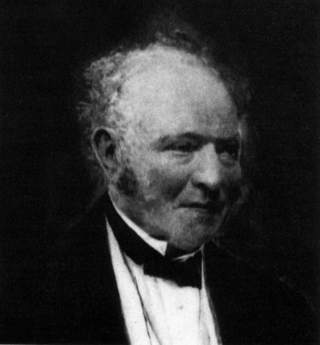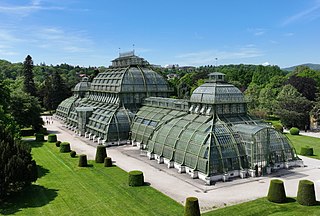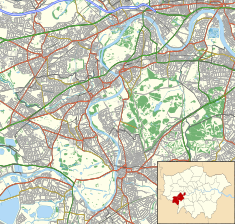
The National Botanic Gardens is a botanical garden in Glasnevin, 5 km north-west of Dublin city centre, Ireland. The 19.5 hectares are situated between Glasnevin Cemetery and the River Tolka where it forms part of the river's floodplain.

A botanical garden or botanic garden is a garden with a documented collection of living plants for the purpose of scientific research, conservation, display, and education. Typically plants are labelled with their botanical names. It may contain specialist plant collections such as cacti and other succulent plants, herb gardens, plants from particular parts of the world, and so on; there may be greenhouses, shadehouses, again with special collections such as tropical plants, alpine plants, or other exotic plants.

The Birmingham Botanical Gardens are a 15-acre (6-hectare) botanical garden situated in Edgbaston, Birmingham, England. The gardens are located 1+1⁄2 miles (2.4 km) south-west of Birmingham city centre at grid reference SP049854. Designed in 1829, the gardens are Grade II* listed in Historic Englands's Register of Parks and Gardens, and retain many original features and layout, which was designed by the landscape gardener and horticulturalist John Claudius Loudon. The site is notable for its range of glasshouses and gardens, which display a wide variety of plants and birds. Birmingham Botanical Gardens is managed by Birmingham Botanical and Horticultural Society, a registered charity. The gardens are open daily to the public with paid admission.

Richard Turner (1798–1881) was an Irish iron founder and manufacturer of glasshouses, born in Dublin. He is rated as one of the most important glasshouse designers of his time. His works included the Palm House at Kew Gardens, the glasshouse in the Winter Gardens at Regent's Park in London, the Palm House at Belfast Botanic Gardens and the Curvilinear Range at the Irish National Botanic Gardens, Glasnevin, Ireland.

A conservatory is a building or room having glass or other transparent roofing and walls, used as a greenhouse or a sunroom. Usually it refers to a space attached to a conventional building such as a house, especially in the United Kingdom. Elsewhere, especially in America, it can often refer to a large freestanding glass-walled building in a botanic garden or park, sometimes also called a palm house if tall enough for trees. Municipal conservatories became popular in the early 19th century.

The Royal Botanic Garden Edinburgh (RBGE) is a scientific centre for the study of plants, their diversity and conservation, as well as a popular tourist attraction. Founded in 1670 as a physic garden to grow medicinal plants, today it occupies four sites across Scotland—Edinburgh, Dawyck, Logan and Benmore—each with its own specialist collection. The RBGE's living collection consists of more than 13,302 plant species, whilst the herbarium contains in excess of 3 million preserved specimens.

Lalbagh Botanical Garden or simply Lalbagh, is an botanical garden in Bangalore, India, with an over 200-year history. First planned and laid out during the dalavaiship of Hyder Ali, the garden was later managed under numerous British Superintendents before Indian Independence. It was responsible for the introduction and propagation of numerous ornamental plants as well as those of economic value. It also served a social function as a park and recreational space, with a central glass house dating from 1890 which was used for flower shows. In modern times, it hosts two flower shows coinciding with the week of Republic Day and Independence Day. As an urban green space along with Cubbon Park, it is also home to numerous wild species of birds and other wildlife. The garden also has a lake adjoining a large rock on which a watchtower had been constructed during the reign of Kempegowda II.

The Royal Botanic Garden, Sydney is a heritage-listed major 30-hectare (74-acre) botanical garden, event venue and public recreation area located at Farm Cove on the eastern fringe of the Sydney central business district, in the City of Sydney local government area of New South Wales, Australia.

RHS Garden Wisley is a garden run by the Royal Horticultural Society in Wisley, Surrey, south of London. It is one of five gardens run by the society, the others being Harlow Carr, Hyde Hall, Rosemoor, and Bridgewater. Wisley is the second most visited paid entry garden in the United Kingdom after the Royal Botanic Gardens, Kew, with 1,232,772 visitors in 2019.

Glasgow Botanic Gardens is a botanical garden located in the West End of Glasgow, Scotland. It features several glasshouses, the most notable of which is the Kibble Palace.

Botanic Gardens is a public garden in Belfast, Northern Ireland.

Palm house is a term sometimes used for large and high heated display greenhouses that specialise in growing palms and other tropical and subtropical plants. In Victorian Britain, several ornate glass and iron palm houses were built in botanical gardens and parks, using cast iron architecture. Especially in English-speaking countries outside the British Isles, these are often called conservatories, in the UK mainly a term for small glass structures attached to houses.

Cast-iron architecture is the use of cast iron in buildings and objects, ranging from bridges and markets to warehouses, balconies and fences. Refinements developed during the Industrial Revolution in the late 18th century made cast iron relatively cheap and suitable for a range of uses, and by the mid-19th century it was common as a structural material, and particularly for elaborately patterned architectural elements such as fences and balconies, until it fell out of fashion after 1900 as a decorative material, and was replaced by modern steel and concrete for structural purposes.

Winterbourne Botanic Garden is a heritage site and botanic garden in Edgbaston, Birmingham, England. It is owned by the University of Birmingham.

Kew Gardens is a botanic garden in southwest London that houses the "largest and most diverse botanical and mycological collections in the world". Founded in 1840, from the exotic garden at Kew Park, its living collections include some of the 27,000 taxa curated by Royal Botanic Gardens, Kew, while the herbarium, one of the largest in the world, has over 8.5 million preserved plant and fungal specimens. The library contains more than 750,000 volumes, and the illustrations collection contains more than 175,000 prints and drawings of plants. It is one of London's top tourist attractions and is a World Heritage Site.

The Enid A. Haupt Conservatory is a greenhouse at the New York Botanical Garden (NYBG) in the Bronx, New York, United States. The conservatory was designed by Lord & Burnham Co. in the Italian Renaissance style. Its major design features are inspired by the Palm House at the Royal Botanic Gardens at Kew, and Joseph Paxton's Crystal Palace.

Treborth Botanic Garden, is a botanic garden in Wales, close to the city of Bangor, Gwynedd. It is owned by Bangor University, and is used in teaching for University students, local schools and community groups. It is also open to the public without charge.
Sir Donald William Insall is a British architect, conservationist and author, who has been described as "one of the leading conservation architects of his generation". He is the founder of the architectural, conservation and architectural consultancy practice, Donald Insall Associates.
Donald Insall Associates is a firm of architects, designers and historic building consultants in the United Kingdom.

The Palm House is a large palm house in the Royal Botanic Gardens, Kew, in London, that specialises in growing palms and other tropical and subtropical plants. It was completed in 1848. Many of its plants are endangered or extinct in the wild. Features include an upper walkway, taking the visitor into the branches of the larger plants. Kew also has the even larger "Temperate House", kept at lower temperatures.





















